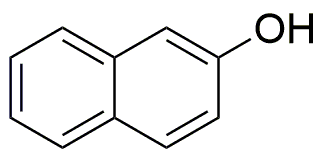2-Naphthol is widely utilized in research focused on:
- Dyes and Pigments: It serves as a key intermediate in the production of various dyes, particularly in the textile industry, where it helps create vibrant colors that are durable and resistant to fading.
- Pharmaceuticals: This compound is involved in the synthesis of several pharmaceutical agents, providing essential properties for medicinal applications, including analgesics and anti-inflammatory drugs.
- Antioxidants: 2-Naphthol is used in the formulation of antioxidants, which are crucial in preventing oxidative damage in food products and cosmetics, thereby extending shelf life and enhancing product stability.
- Research Reagent: In laboratories, it acts as a reagent in various chemical reactions, facilitating the study of organic compounds and improving the efficiency of synthetic processes.
- Biochemical Applications: It is utilized in biochemical assays to detect and quantify certain enzymes, making it valuable in both clinical and environmental testing.
General Information
Properties
Safety and Regulations
Applications
2-Naphthol is widely utilized in research focused on:
- Dyes and Pigments: It serves as a key intermediate in the production of various dyes, particularly in the textile industry, where it helps create vibrant colors that are durable and resistant to fading.
- Pharmaceuticals: This compound is involved in the synthesis of several pharmaceutical agents, providing essential properties for medicinal applications, including analgesics and anti-inflammatory drugs.
- Antioxidants: 2-Naphthol is used in the formulation of antioxidants, which are crucial in preventing oxidative damage in food products and cosmetics, thereby extending shelf life and enhancing product stability.
- Research Reagent: In laboratories, it acts as a reagent in various chemical reactions, facilitating the study of organic compounds and improving the efficiency of synthetic processes.
- Biochemical Applications: It is utilized in biochemical assays to detect and quantify certain enzymes, making it valuable in both clinical and environmental testing.
Documents
Safety Data Sheets (SDS)
The SDS provides comprehensive safety information on handling, storage, and disposal of the product.
Product Specification (PS)
The PS provides a comprehensive breakdown of the product’s properties, including chemical composition, physical state, purity, and storage requirements. It also details acceptable quality ranges and the product's intended applications.
Certificates of Analysis (COA)
Search for Certificates of Analysis (COA) by entering the products Lot Number. Lot and Batch Numbers can be found on a product’s label following the words ‘Lot’ or ‘Batch’.
*Catalog Number
*Lot Number
Certificates Of Origin (COO)
This COO confirms the country where the product was manufactured, and also details the materials and components used in it and whether it is derived from natural, synthetic, or other specific sources. This certificate may be required for customs, trade, and regulatory compliance.
*Catalog Number
*Lot Number
Safety Data Sheets (SDS)
The SDS provides comprehensive safety information on handling, storage, and disposal of the product.
DownloadProduct Specification (PS)
The PS provides a comprehensive breakdown of the product’s properties, including chemical composition, physical state, purity, and storage requirements. It also details acceptable quality ranges and the product's intended applications.
DownloadCertificates of Analysis (COA)
Search for Certificates of Analysis (COA) by entering the products Lot Number. Lot and Batch Numbers can be found on a product’s label following the words ‘Lot’ or ‘Batch’.
*Catalog Number
*Lot Number
Certificates Of Origin (COO)
This COO confirms the country where the product was manufactured, and also details the materials and components used in it and whether it is derived from natural, synthetic, or other specific sources. This certificate may be required for customs, trade, and regulatory compliance.


